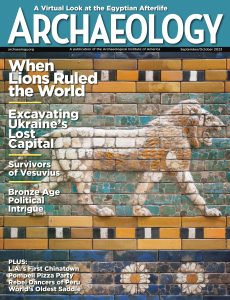
Archaeology – September-October 2023
English | 72 pages | pdf | 25.84 MB
CONFLICTING FORCES
Conflict is an inescapable feature of human society. In Archaeology Magazine September-October 2023 issue, you will read about a variety of conflicts and how the archaeological record preserves some of the ways that people across time have waged and resolved them. The discovery of musket balls at the site of Fort Necessity in Pennsylvania attests to a skirmish in 1754. Despite its seeming insignificance, this brief battle sparked the Seven Years’ War, a sprawling conflict that engulfed much of the world. Another military confrontation you’ll encounter in the issue is the Great Northern War, a pivotal part of which is explored in “Ukraine’s Lost Capital.” This early eighteenth-century conflict was fought between the forces of the Swedish king Charles XII and the Russian czar Peter I. One of the war’s casualties was the Cossack capital of Baturyn in north-central Ukraine, which flourished as a center of arts and culture under Ivan Mazepa, its cosmopolitan ruler. The people of Baturyn paid dearly for Mazepa’s refusal to follow Peter, despite having once been his staunch ally. The czar burned the city to the ground,
leaving archaeologists to rediscover its ruined splendor. You’ll also read,
in “When Lions Were King,” about a war between the Mauryan Dynasty of India and its neighbors in the territory of Kalinga. This brutal and bloody conflict went on for decades, a traumatic experience that resulted in the Mauryan emperor Ashoka converting to Buddhism.
Sometimes conflicts are resolved by less violent means. More than 3,000 years ago, in the mid-thirteenth century b.c., the king of the mighty Hittite Empire, Hattusili III, was frustrated by the activities of Piyamaradu, a rogue warlord who pillaged Hittite territory. He appealed for help to a brother king, the ruler of the land of Ahhiyawa—which scholars believe refers to a Mycenaean city-state in Greece. Piyamaradu’s raids are recorded in tablets preserving Hittite diplomatic correspondence. Although a solution to Hattusili’s problem was not reached, “Bronze Age Power Players” explores a valiant attempt to end the conflict peacefully.
Conflict can also come in the form of resistance. “Rites of Rebellion” tells the fascinating story of how 500 years ago some inhabitants of Peru resisted Spanish domination by combin-ing their own rites celebrating the dead with those imposed on them by the Catholic clergy. They also engaged in a frenetic ritual called the Taki Onqoy, or “dancing sickness,” as a way to ward off Spanish efforts to forcibly convert them to Catholicism. And, sometimes a simple object, like the padlock featured in this issue’s Artifact, can enable small acts of resistance by enslaved people seeking their freedom.
Download from: